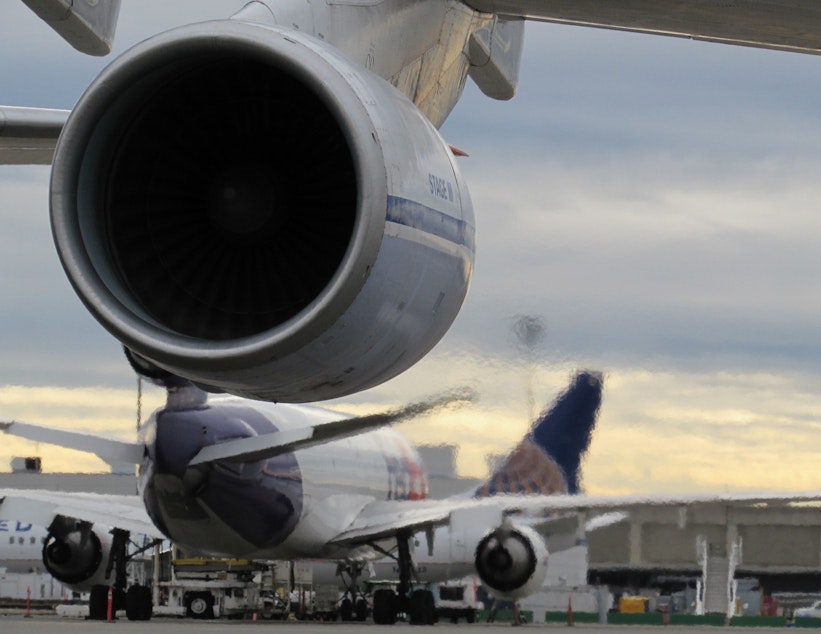Green airplanes? Not on the horizon yet

Nearly half the planes flying out of Seattle and Portland airports could — some day — run on plant-based fuel made in the Northwest.
But don’t expect that day any time soon.
Kicking aviation’s climate-harming carbon habit is likely to be a long, slow climb, made more difficult as the industry continues to expand rapidly.
“There will be more airplanes,” Tony Gonchar from Delta Airlines said. “There will be a larger airport here at Sea-Tac.”
Aviation and energy experts gathered Thursday in Seattle’s Bell Harbor conference center to discuss how to get the supply of climate-friendly alternatives to jet fuel off the ground.
Airlines and airplane manufacturers have been investing in more-efficient hardware to enable newer jets to guzzle less fuel, but they’re not making headway in taming the sector’s worsening climate impact.
“The industry is growing so rapidly that it's outgrowing the pace of these technological and operation advances, so the only way, then, to do it is through decarbonizing the fuel,” engineering professor Michael Wolcott with Washington State University said.
Sponsored
The Port of Seattle, which operates Sea-Tac International Airport, has a goal of getting 10 percent of its jet fuel from local, low-carbon sources a decade from now and 25 percent by 2035.
Those sources could include oilseed crops like canola, greasy waste from restaurants and slaughterhouses and piles of wood left by logging operations.
Wolcott said, in theory, there’s enough raw material in the Northwest to produce 400 million gallons of renewable jet fuel a year.
Energy giant BP advertises its “banana fuel”— jet fuel made from food waste. But food waste, while abundant, can’t hold a candle to all the energy used in the aviation sector.
Converting all the waste fats and greases in the U.S. into renewable jet fuel would produce 2 billion gallons of fuel, according to renewable-energy investor Bruce Comer with Ocean Park Advisors.
Sponsored
That’s only about the annual fuel usage at Los Angeles International Airport.
In addition, many of those “wastes” aren’t really wastes, Comer said: They are often converted into other products like animal feed and detergents.
For the towering piles of logging “slash” left behind after timber operations around the Northwest, supply isn’t the problem.
“We burn these slash piles, and now they're a liability to society because we deal with their smoke,” Wolcott said.
Collecting them and processing them into fuel could tackle the smoke problem as well as provide a new source of energy.
Sponsored
But building a refinery to process forest residue into fuel can be a risky, billion-dollar venture, according to Wolcott.
“There are there more than 100 feedstocks today that are actually being used to create sustainable fuels,” former Secretary of the Navy Ray Mabus said. “We have to do this with a real sense of urgency,” he said.
As Secretary of the Navy during the Obama administration, Mabus set a goal that more than half the energy the Navy used would come from non-fossil fuel sources by 2020.
He said the Navy expects to meet that goal by next year.
Mabus said the Pentagon is continuing to use biofuels under the Trump administration not because of any environmental benefits but because they make the armed forces more effective.
Sponsored
“We have SEAL teams that are net zero in terms of energy,” Mabus said. “They can stay out almost indefinitely.”
Renewable-energy advocates said Washington was behind other West Coast states in promoting clean fuels. They called upon Washington legislators to pass a clean fuel standard that would give renewable fuels a guaranteed slice of the market.
What little renewable fuel is produced in Washington today is usually shipped down to California, which has a clean fuel standard.
The vast majority of biofuel produced in the United States is ethanol made from corn. Ethanol’s carbon footprint rivals that of regular gasoline, and growing it takes up about 40 percent of all corn grown in the country and millions of acres of American cropland.
The Port of Seattle and others’ definitions of sustainable fuel require that it have a reduced carbon footprint and that it not displace any food production.
Sponsored
Other major emitters of climate-wrecking carbon — like cars and buildings — can run on electricity more easily. But banks of batteries are a lot heavier than tanks of fuel, and long-haul air transport is expected to depend on liquid fuel for the foreseeable future.




